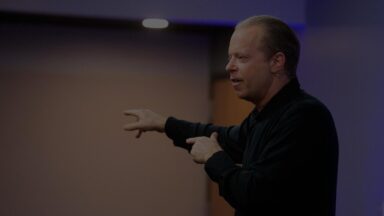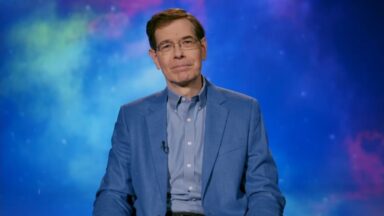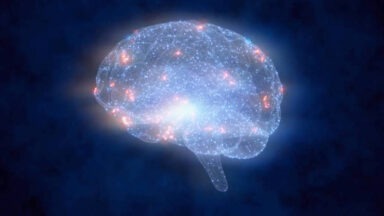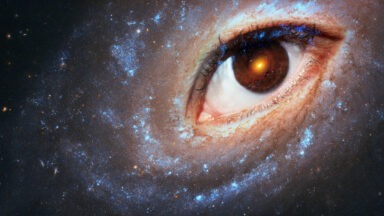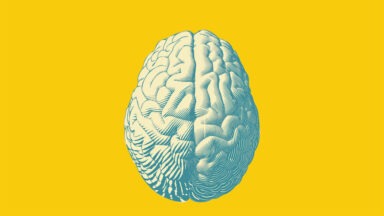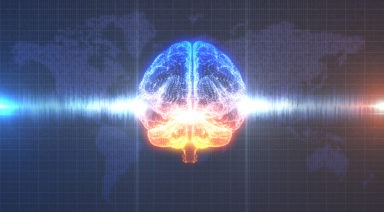Could Quantum Entanglement Explain Telepathic Communication?
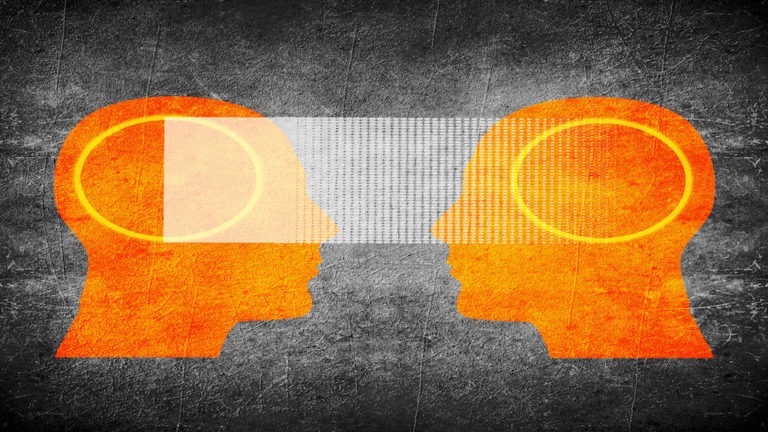
A few years ago, an experiment allowed a test subject in India to communicate with someone in France without speaking or typing. Later that year, another group developed a telepathic interface that allowed two people to collaborate using their minds to play a video game. But these telepathic modalities for our tech gadgets seem analog compared to the psychic telepathy many of us experience at some point in our lives. Could quantum entanglement bridge the gap?
Telepathy Research
Brain-to-brain communication, or what most of us might call telepathy, is currently being developed to build more advanced, convenient interfaces for technology we use today. Though it’s pretty slow at the moment, these interfaces may soon be used to telepathically manipulate wireless devices, control prosthetics, and communicate in new ways.
Our brains are an intricate network of neurons and synapses transmitting electrical signals that become memories, commands, and ideas. And when these neurons transmit data back and forth, they in turn create brain waves, or synchronous oscillations that aggregate and transfer information across different segments of the brain.
Today, those brain waves can be externally translated through the use of electroencephalography, or an EEG cap. These swim caps dotted with electrodes continuously measure the brain’s electric signals in different regions, translating them to data that can pinpoint where in the brain those signals are coming from and what their general intentions are.
In a 2014 experiment, researchers made a breakthrough with a new interface that allowed signals from an individual’s brain to manipulate a robotic exoskeleton, allowing a once-paralyzed man to deliver the opening kick at the World Cup. Scientists involved in these experiments believe they portend a future in which this technology becomes so common, that we will surf the internet and manipulate our devices using thought alone.
So, Does Telepathy Exist?
In this sense, telepathic communication has essentially been proven possible, but what about the type of telepathic phenomena we experience naturally? Most people have experienced some type of uncanny ESP, whether it comes in the form of precognition, clairvoyance, intuition, or remote projection.
But if this phenomenon was measured in the way that brain interfaces work, we would expect to see things like a decay of the brain wave signal over long distances, or interference from other brain wave emissions. Instead, when we experience ESP phenomena, it seems impervious to these things. But, why?
Rupert Sheldrake’s theory of morphic resonance proposes an idea whereby all self-organizing systems in nature tap into a sort of collective memory that is not stored in the brain. Instead, this inherited memory exists psychically and can be accessed without regard to distance.
One aspect of this concept is that memory is passed down through genetics, but not in the sense that the information is written in to our DNA. To the contrary, Sheldrake provides the example of the failure of the Human Genome Project, which was unable to predict whether disease or physical attributes would be passed down based on one’s DNA.
Even for something as simple as height, it turned out that the information gleaned from genetic sequencing provided only five percent confidence in predicting the height of subjects’ progeny, compared to 80 percent confidence in simply measuring the parents’ height.
Instead, this collective memory seems to be passed on within groups of the same species that coexist together, and the more tight-knit a group is, the stronger a psychic bond exists.
In nature, this can be seen in the flocking behavior of birds or fish. When these animals swarm in schools or murmurations they change directions sharply without running into each other. This hive mindset is something unexplained by science, while evidence of some type of telepathic communication may be likely.
But what is the mechanism behind all this? Could it be explained by quantum theory?
The Possible Quantum Explanation
Physicists aren’t fond of what’s becoming a hackneyed theory that there may be a link between quantum physics and our consciousness; nonetheless there seems to be increasing evidence of a connection.
Einstein wasn’t the biggest fan of quantum entanglement, dismissing it as “spooky action at a distance,” because it didn’t fit into his general theory of relativity. But quantum entanglement is now a proven concept being used for quantum computing, and some physicists believe it could play a role in our consciousness.
Sir Roger Penrose first proposed the idea of a connection between quantum processes and consciousness, and he was quickly ostracized for it. The idea was considered sacrilegious to his materialist colleagues, who believed consciousness to be a physical product of the brain.
However, there has been another wave of acceptance for this theory supported by the research of esteemed U.C. Santa Barbara physicist Matthew Fischer. His theory came to him while he was recovering from depression.
Fischer was prescribed antidepressants finding them highly effective and able to lift him out of his slump. But he was astounded to learn that modern medicine doesn’t really have any idea why anti-depressants work the way they do to affect brain function.
Fischer did some research and found an experiment in which scientists gave mice two different isotopes of lithium and observed their behavior. He found that the mice given lithium-6 showed stronger maternal behaviors compared to those given lithium-7. The only difference between the two ions? Nuclear spin.
Nuclear spin determines how long an atom can remain in an entangled state, or how long it remains coherent. With lower spins, the nucleus of the atom interacts with electric and magnetic fields less, slowing its decoherence. In the mice’s brain, the lithium-7 with a higher spin would decohere too quickly, but the lithium-6 worked, despite just a one neutron difference in weight.
This led Fischer to the idea that lithium might interact with the brain through quantum entanglement – for particular chemicals, the spin needs to be just right to entangle with neurons in the brain. This had the profound implication that our cognition may involve quantum processes.
Dean Radin is one of the most notable names studying what he calls “entangled minds.” Radin is the Chief Scientist at the Institute of Noetic Sciences and has devoted much of his career to studying psychic phenomena, under the premise that quantum entanglement may bridge the gap between a seemingly paranormal function and provable science.
Radin says that based on 17th century science, or Newtonian physics, it’s easy to consider telepathy and psychic phenomena as paranormal, but now that quantum entanglement has been proven, and separate objects can be connected at great distances, psi could potentially become a replicable, natural function.
In this regard, it may be possible that the universe itself could be a single, self-entangled object and so could our brains. And if quantum physics is able to prove this, it just might change our entire conception of reality and consciousness itself.
Watch Regina Meredith’s interview with Dean Radin on Open Minds below:
What Is Remote Viewing and How Is It Developed?

Table of Contents
- What Is Remote Viewing?
- Stanford Research and the Origins of Remote Viewing
- Understanding the Difference Between Clairvoyance and Remote Viewing
- Remote Viewing Training: How to Practice and Actionable Techniques
- Can Everyone Develop Remote Viewing?
- Spiritual Benefits of Developing Remote Viewing
- Myths and Facts About the Art of Remote Viewing
- The Continuing Debate Around Remote Viewing
What Is Remote Viewing?
Remote viewing is one of the most advanced psychic abilities and a structured practice of extrasensory perception (ESP) that allows a remote viewer to describe or gather information about a distant target site using only the mind. Unlike traditional sensory perception, this technique seeks impressions of locations, objects, or events without relying on the five physical senses. Supporters view it as a disciplined method of accessing hidden information, while skeptics often consider it a form of psychic phenomena without scientific proof.
The concept of remote viewing has been explored in both spiritual and experimental settings, where researchers and practitioners alike have tested whether the human mind can access information beyond normal perception. Reports of successful sessions describe participants sketching landscapes, describing structures, or identifying key features of a location they have never physically visited.
The process follows a multi-stage protocol. A typical remote viewing session begins with relaxation or meditation to quiet mental distractions, followed by setting a clear intention to connect with the chosen target. During the session, the viewer records raw sensory impressions, such as shapes, textures, sounds, or temperatures, before attempting to interpret them. Patience, consistent training, and repeated sessions are considered essential for refining accuracy and building confidence in the results.
Stanford Research and the Origins of Remote Viewing
Remote viewing moved to formal study in the early 1970s when physicists Russell Targ and Harold Puthoff began experiments at the Stanford Research Institute (SRI) in California. Their work sought to determine whether the human mind could obtain information about distant places or objects without ordinary sensory input, a concept they referred to as “remote perception.”
At SRI, trained participants known as remote viewers attempted to describe hidden or distant target sites, locations, objects, or events, while shielded from all conventional cues. Sessions followed a controlled protocol in which viewers recorded mental impressions such as shapes, textures, and spatial relationships. According to reports, some results produced descriptions accurate enough to be statistically significant beyond chance, sparking interest from military and intelligence agencies.
This research eventually attracted funding from the U.S. government, including the CIA and the Department of Defense, under programs like the now-declassified Stargate Project. These initiatives explored whether remote viewing could aid intelligence gathering during the Cold War and led to decades of classified testing. While the studies generated intriguing data, critics highlighted issues with experimental controls and the often vague nature of the information obtained. Today, despite Targ’s continued advocacy and writings on the subject, mainstream science generally regards remote viewing as pseudoscience, noting that no reproducible evidence confirms it as a reliable phenomenon.
Understanding the Difference Between Clairvoyance and Remote Viewing
Clairvoyance and remote viewing are psychic abilities used to obtain information beyond the physical senses, yet their goals and methods differ in key ways. Clairvoyance is the ability to receive spontaneous or intentional visual impressions about people, places, or events outside normal sensory range. It can arise as a natural gift or be developed through training, allowing a person to perceive images, colors, symbols, or entire scenes that appear within the mind’s eye.
Remote viewing, by contrast, is a carefully structured form of remote perception designed to describe details of a distant target site without physical access. This skill follows a defined protocol to collect accurate and verifiable data. During a remote viewing session, the viewer records raw sensory impressions, such as shapes, sounds, textures, or spatial relationships, while using systematic methods to reduce conscious analysis and outside influence.
The range of information also differs. Clairvoyants may receive broad, symbolic visions or intuitive messages that require interpretation, including insights about a person’s emotions, potential future events, or abstract themes. Remote viewers, on the other hand, focus on describing specific, tangible characteristics of the target, such as geographic features, structural elements, or measurable details that can later be checked against reality.
Although both practices claim access to knowledge beyond the five senses, clairvoyance remains more subjective and open-ended, while remote viewing emphasizes repeatable steps and data that can be compared to actual outcomes. These distinctions give each practice its own set of applications and training approaches, offering different pathways for exploring extrasensory perception.

How to Remote View
Remote viewing is presented as a disciplined way to gather information about a distant target site through focused mental perception. Rather than waiting for spontaneous visions, a remote viewer follows structured steps to capture sensory impressions and record them for later verification. Training focuses on relaxing the body, calming the mind, and developing the ability to notice subtle impressions without letting analysis interfere.
Mental Preparation and Focus
Begin by creating a quiet environment where you can relax and settle your thoughts. Deep breathing or meditation reduces mental noise and strengthens concentration. Practitioners set a clear intent to perceive details about the target while keeping thoughts neutral. This focused state supports the reception of impressions that might otherwise be missed.
The Viewing Process
During a remote viewing session, a monitor or assistant may provide a neutral cue for the hidden target. Quickly note the first impressions—colors, shapes, sounds, or temperatures—without naming the object or trying to interpret it. Recording these raw perceptions before analysis helps preserve data that can later be matched to the target. Treat each sensation as information, even if it seems random.
Development and Refinement
Consistent practice strengthens accuracy and detail in remote viewing work. After each session, compare your notes with the actual target to identify patterns and improve precision. Over time, this routine builds confidence and reliability while helping you expand from basic impressions to more complex sensory details.
Beginner Practice Exercise
Developing remote viewing requires practice and a systematic approach. Here is a simple exercise you can do to start training this skill:
- Select Targets: Ask a friend or family member to choose 5–10 varied images from magazines, such as landscapes, people, or objects.
- Prepare the Envelopes: Have your assistant place each image face down in a sealed envelope and keep the contents secret.
- Calm Your Mind: Find a quiet spot, close your eyes, and breathe deeply to reduce distractions.
- Set the Stage: Write down the date, time, and any distracting thoughts to clear your mind before you begin.
- Describe the Target: Without opening the envelope, write down the first basic impressions that arise, textures, colors, patterns, movements, without judgment or analysis.
- Draw a Sketch: Create a rough sketch of the shapes or structures you sensed. Artistic skill is not important; focus on capturing the essence of the impressions.
- Get Feedback: Open the envelope and compare your notes and sketch with the actual image. Reflect on similarities and differences to learn from the session.
This foundational exercise provides immediate feedback and helps develop the mental discipline that supports more advanced techniques. By repeating the process and reviewing your notes after every session, you begin to recognize subtle patterns, sharpen your attention to small sensory details, and train your mind to capture impressions before analysis sets in. Over time, these habits create the steady focus and self-awareness needed to attempt longer sessions, more complex target sites, and the structured protocols used by experienced remote viewers.
Can Everyone Develop Remote Viewing?
Remote viewing is a skill that most people can learn and improve with steady practice. While a few individuals may show natural sensitivity from the start, consistent training is what allows the majority of students to strengthen their abilities over time. Progress depends less on innate “psychic powers” and more on patience, focus, and regular sessions that teach the mind to notice subtle impressions.
Key factors that support development include:
- Regular practice: Short, frequent sessions help train attention and reduce mental noise.
- Strong concentration: The ability to maintain a quiet, alert mind is critical for receiving accurate impressions.
- Open mindset: Curiosity and a willingness to record even faint or unexpected impressions prevent early filtering.
- Structured methods: Following a step-by-step protocol or guided training provides consistent feedback and measurable improvement.
- Patience and perseverance: Results may start small, but skill grows as the mind learns to separate fleeting thoughts from genuine target information.
Spiritual Benefits of Developing Remote Viewing
Remote viewing is more than a method for gathering impressions about a distant target site. Practicing it over time can transform the way you experience the world and your inner self. Training as a remote viewer calls for quiet focus, disciplined attention, and regular sessions, and these habits naturally foster deeper awareness and a stronger sense of connection. Many people find that the mental discipline required for remote viewing work carries over into everyday life, creating benefits that go far beyond the sessions themselves.
Below are some of the most frequently reported spiritual and personal gains:
- Spiritual connection: Regular practice encourages a stronger bond with the universe and with your own inner life. This deeper connection can spark insight into personal purpose and the larger patterns of existence.
- Expanded awareness: Reaching for information beyond ordinary senses stretches perception and helps you recognize the interdependence of all things. Over time, many viewers describe a heightened sensitivity to subtle patterns in daily life.
- Sharper intuition: Recording and reviewing impressions during a remote viewing session strengthens subtle perception. Many practitioners notice clearer gut feelings and more confidence when making important choices.
- Relaxation and balance: The quiet, focused state required for each session naturally promotes deep relaxation. This meditative practice can reduce stress and support steady emotional balance.
- Personal growth: Working with remote viewing often reveals self-imposed limits. Meeting those challenges builds patience, resilience, and a broader perspective on the capabilities of the human mind.
Myths and Facts About the Art of Remote Viewing
Remote viewing has always carried an air of mystery, which makes it easy for rumors and misconceptions to spread. Sorting myth from reality helps anyone interested in the practice approach it with realistic expectations and a clear understanding of what this remote perception technique can and cannot do.
Remote Viewing Myths
- For psychics only: Many believe that only gifted psychics or psychic mediums can succeed as remote viewers. In truth, structured training protocols show that people without any prior extrasensory experience can learn the process.
- Dangerous to the mind: Some worry that remote viewing might cause mental harm or invite negative forces. When practiced with proper guidance, it is no more harmful than meditation or focused visualization.
- Unlimited access: A frequent claim is that a skilled viewer can observe anything, anywhere, at any time. In practice, sessions often yield partial impressions, symbolic fragments, or ambiguous details rather than unlimited surveillance.
- Guaranteed accuracy: Movies and sensational reports sometimes suggest that trained viewers always describe a target site with perfect precision. In reality, even experienced practitioners have sessions where impressions are vague, contradictory, or incorrect.
- Proof of supernatural powers: Supporters sometimes frame successful sessions as unquestionable evidence of psychic powers. Skeptics counter that hits can stem from coincidence, selective memory, or subconscious pattern recognition, so results remain open to debate.
Remote Viewing Facts
- Requires steady practice: Consistent training, patience, and honest feedback are essential. Progress comes from refining mental discipline and learning to separate subtle impressions from imagination.
- Documented research history: Programs at institutions like the Stanford Research Institute (SRI) and government projects such as Stargate show that the topic has been tested under controlled conditions, even though the scientific community remains divided on its validity.
- Not infallible: A single session may contain both accurate and inaccurate details. Statistical studies have found results better than chance in some cases, but no protocol eliminates human error or subjective interpretation.
- Often labeled a pseudoscience: Despite decades of experiments, remote viewing lacks a mechanism recognized by mainstream science. Researchers describe it as a form of extrasensory perception (ESP), but its status remains unproven and controversial.
The Continuing Debate Around Remote Viewing
Remote viewing remains a topic that straddles the line between curiosity, research, and controversy. Decades after the early experiments at SRI and the CIA’s Stargate Project, interest in the practice continues in spiritual circles, private training groups, and online communities. Supporters point to statistically significant studies and personal experiences as evidence that the human mind may have abilities beyond ordinary senses. Skeptics view those same results as chance, methodological flaws, or creative interpretation rather than proof of genuine psychic phenomena.
Whether approached as a meditative discipline, a tool for exploring consciousness, or simply a historical curiosity, remote viewing invites people to test the limits of perception for themselves. Practicing relaxation, careful observation, and structured feedback can strengthen focus and intuition even if no “psychic spy” skills emerge. By understanding the myths, research history, and training methods, readers can decide how much of this psychic phenomenon feels meaningful while maintaining a grounded perspective on what remains unverified.








